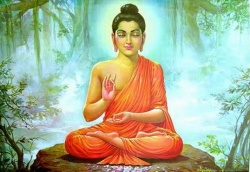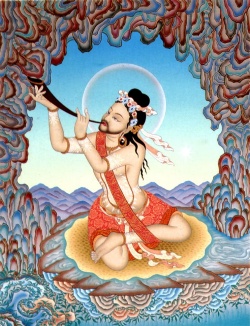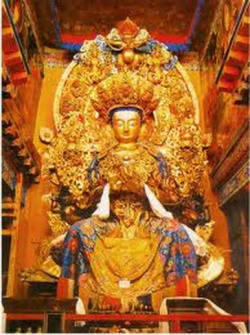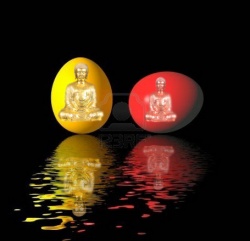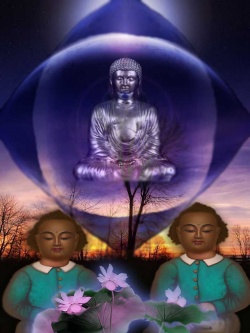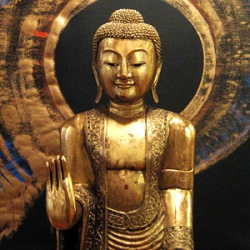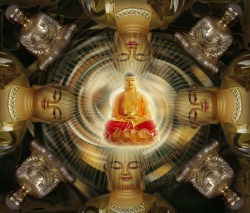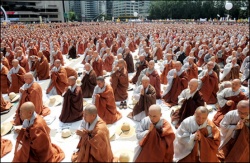Difference between revisions of "Indian Cosmology - Reflections in Religion and Metaphysics"
m (Text replacement - "application" to "application") |
|||
| (5 intermediate revisions by one other user not shown) | |||
| Line 1: | Line 1: | ||
| − | + | {{DisplayImages|3889|3617|643|320|1230|660|1994|2365|814|3487|4228|1898|619|3246|2633|4071|305|904|796|2585|2299}} | |
by A. K. Chakravarty | by A. K. Chakravarty | ||
| − | The exact origin of astronomical studies in [[India]] is not known to us though it is fairly clear that it eventually formed part of [[ancient]] {{Wiki|Vedic}} [[people]]. The earliest text on this [[subject]] now available, [[Vedanga]] Jyotisa, aims at determining the most suitable time for performing a [[yajna]] in [[consideration]] of the luni-solar-stellar situation at that time. The [[subject]] was based on so crude astronomical parameters that its failure could not escape the notice of any sky-watcher, till then it was never questioned by anybody perhaps because of its association with [[religious]] yajnas. This scheme of {{Wiki|astronomy}} survived for some 2000 years. | + | The exact origin of astronomical studies in [[India]] is not known to us though it is fairly clear that it eventually formed part of [[ancient]] {{Wiki|Vedic}} [[people]]. The earliest text on this [[subject]] now available, [[Vedanga]] [[Jyotisa]], aims at determining the most suitable time for performing a [[yajna]] in [[consideration]] of the luni-solar-stellar situation at that time. The [[subject]] was based on so crude astronomical parameters that its failure could not escape the notice of any sky-watcher, till then it was never questioned by anybody perhaps because of its association with [[religious]] [[yajnas]]. This scheme of {{Wiki|astronomy}} survived for some 2000 years. |
In later [[India]], these parameters were scraped, scope of {{Wiki|astronomy}} was extended to include natural [[phenomena]], like, {{Wiki|eclipses}}, identification of {{Wiki|planets}} and formulations of their motions, etc., till then astronomers often invoked [[metaphysics]] to explain [[cosmological]] facts. It occurs to us that the general [[people]] of that period in that class-ridden [[society]] was more [[interested]] in earning punyaphala through [[religious]] functions than acquiring [[pure]] [[knowledge]]. Astronomers could not or did not ignore this sentiment and so, to honour this sentiment, they found it necessary to blend [[religion]] and [[metaphysics]] with [[cosmology]] in an astronomical background. [[Science]] in [[ancient]] times had to be supplemented by speculative materials and was thus mixed up with [[myths]] and [[metaphysics]]. | In later [[India]], these parameters were scraped, scope of {{Wiki|astronomy}} was extended to include natural [[phenomena]], like, {{Wiki|eclipses}}, identification of {{Wiki|planets}} and formulations of their motions, etc., till then astronomers often invoked [[metaphysics]] to explain [[cosmological]] facts. It occurs to us that the general [[people]] of that period in that class-ridden [[society]] was more [[interested]] in earning punyaphala through [[religious]] functions than acquiring [[pure]] [[knowledge]]. Astronomers could not or did not ignore this sentiment and so, to honour this sentiment, they found it necessary to blend [[religion]] and [[metaphysics]] with [[cosmology]] in an astronomical background. [[Science]] in [[ancient]] times had to be supplemented by speculative materials and was thus mixed up with [[myths]] and [[metaphysics]]. | ||
| − | The period of the 5-yearly cycle in [[Vedanga]] and [[Jain]] Jyotisa | + | The period of the 5-yearly cycle in [[Vedanga]] and [[Jain]] [[Jyotisa]] |
| − | The [[Vedanga]] Jyotisa (VJ) is [[essentially]] a guidebook for finding positions of the {{Wiki|sun}} and [[moon]] in the asterism divisions (naksatras) at [[parvas]] (new or [[full moon]]), the beginning or ending [[moment]] of a [[parva]] in the day, the tithis and naksatras in which the {{Wiki|solstices}} occur and above all, the description of a 5-yearly cycle ([[Yuga]]). We shall consider this [[yuga]] in further details in a later section, for the {{Wiki|present}} we [[state]] that the text itself says ([[Yajus]] 2, 3) that yajnas are to be performed in proper time, and {{Wiki|astronomy}} is the [[science]] of time. One who [[knows]] this [[science]] of time also [[knows]] yajnas. | + | The [[Vedanga]] [[Jyotisa]] (VJ) is [[essentially]] a guidebook for finding positions of the {{Wiki|sun}} and [[moon]] in the asterism divisions ([[naksatras]]) at [[parvas]] (new or [[full moon]]), the beginning or ending [[moment]] of a [[parva]] in the day, the [[tithis]] and [[naksatras]] in which the {{Wiki|solstices}} occur and above all, the description of a 5-yearly cycle ([[Yuga]]). We shall consider this [[yuga]] in further details in a later section, for the {{Wiki|present}} we [[state]] that the text itself says ([[Yajus]] 2, 3) that [[yajnas]] are to be performed in proper time, and {{Wiki|astronomy}} is the [[science]] of time. One who [[knows]] this [[science]] of time also [[knows]] [[yajnas]]. |
Now, major part of this text is obscure or corrupt in [[form]]. We give one specific illustration. | Now, major part of this text is obscure or corrupt in [[form]]. We give one specific illustration. | ||
| − | + | : [[Yajus]] 12: [[Duheyang]] [[parva]] chet pade. . . | |
| − | A straightforward translation of it is: If a [[parva]] ends in a quarter of a day, then duheya it. But, according to Tilak, "there is no [[verbal]] [[form]] as | + | A straightforward translation of it is: If a [[parva]] ends in a quarter of a day, then [[duheya]] it. But, according to [[Tilak]], "there is no [[verbal]] [[form]] as [[duheyang]] or even [[duheya]] in [[sanskrit]]". |
| − | + | As shown in 3, the astronomical contents of the VJ appear to be earlier than the period of {{Wiki|Vedic}} [[Aryan]] and hence the presumption is that the text contains certain words and {{Wiki|expressions}} inherited from an unknown earlier [[language]]. Hence the commentator [[Somakara]] often fails to make a clear [[sense]] of many words in the text. Many {{Wiki|modern}} [[scholars]], tactly assuming that it is a textual corruption try to suggest what the original [[word]] could have been. We cite two examples only. | |
| − | Dixit’s emendation makes the meaning: if a [[parva]] ends in a quarter of a day, observe {{Wiki|tithi}} on that quarter. | + | [[Tilak]] suggests here [[dyu heyang]] (day to be omitted) to make the meaning: if a [[parva]] ends in a quarter of a day, then that day is to be omitted, i.e., no {{Wiki|tithi}} [[rites]] (like [[fasting]], bathing, etc.) should not be performed on that day. |
| + | |||
| + | [[Dixit’s]] emendation makes the meaning: if a [[parva]] ends in a quarter of a day, observe {{Wiki|tithi}} on that quarter. | ||
It is now almost impossible to know what the original author intended to say. Only this much is obvious that the verse gives an instruction on [[parva]] [[rites]] should a [[parva]] end in a quarter of a day. | It is now almost impossible to know what the original author intended to say. Only this much is obvious that the verse gives an instruction on [[parva]] [[rites]] should a [[parva]] end in a quarter of a day. | ||
| − | We have stated that {{Wiki|astronomy}} was used as a [[science]] of computing times for yajnas. Time’s role was to be [[auspicious]] or unauspicious for yajnas and had no other role like recording {{Wiki|chronology}}, etc. {{Wiki|Chronology}} has been recorded in contemporary period through a history of genealogical tables as we find in the two great {{Wiki|epics}} and {{Wiki|Puranas}}. In [[Ramayana]], (Bal., 70) [[Vasistha]] gives the chronolgy of {{Wiki|Rama}} in the ancestral order from [[Manu]], {{Wiki|Iksvaku}} and so on up to [[Dasaratha]] and in reply [[Janaka]] stated his ancestral order from Nimi to himself. | + | We have stated that {{Wiki|astronomy}} was used as a [[science]] of computing times for [[yajnas]]. Time’s role was to be [[auspicious]] or unauspicious for [[yajnas]] and had no other role like recording {{Wiki|chronology}}, etc. {{Wiki|Chronology}} has been recorded in contemporary period through a history of genealogical tables as we find in the two great {{Wiki|epics}} and {{Wiki|Puranas}}. In [[Ramayana]], (Bal., 70) [[Vasistha]] gives the chronolgy of {{Wiki|Rama}} in the ancestral order from [[Manu]], {{Wiki|Iksvaku}} and so on up to [[Dasaratha]] and in reply [[Janaka]] stated his ancestral order from [[Nimi]] to himself. |
We construct the following story on origin of the [[science]] of {{Wiki|astronomy}} in {{Wiki|ancient India}}. | We construct the following story on origin of the [[science]] of {{Wiki|astronomy}} in {{Wiki|ancient India}}. | ||
| − | The [[Aryans]] had been performing yajnas since their settlement in [[India]]. It is a separate branch of studies as to whether they formulated these yajnas of their [[own]] or they brought these [[ideas]] from elsewhere. Our {{Wiki|present}} [[concern]] is that they performed various yajnas on different seasons for different purposes and also observed tithi-rites on [[parvas]]. When such functions multiplied in number, the task of maintaining the order or sequence of such functions became somewhat technical and it became necessary to detail a section of {{Wiki|priests}} to specialise in computing times for yajnas. Astronomical {{Wiki|literature}} as it comes down to us owes its [[birth]] to meet this need of the priestly class, and so it is more connected with [[dharmasastras]] than {{Wiki|astronomy}} proper, and accordingly this [[subject]] was named [[Vedanga]], i.e., a limb of the [[Vedas]]. | + | The [[Aryans]] had been performing [[yajnas]] since their settlement in [[India]]. It is a separate branch of studies as to whether they formulated these [[yajnas]] of their [[own]] or they brought these [[ideas]] from elsewhere. Our {{Wiki|present}} [[concern]] is that they performed various [[yajnas]] on different seasons for different purposes and also observed [[tithi]]-[[rites]] on [[parvas]]. When such functions multiplied in number, the task of maintaining the order or sequence of such functions became somewhat technical and it became necessary to detail a section of {{Wiki|priests}} to specialise in computing times for [[yajnas]]. Astronomical {{Wiki|literature}} as it comes down to us owes its [[birth]] to meet this need of the priestly class, and so it is more connected with [[dharmasastras]] than {{Wiki|astronomy}} proper, and accordingly this [[subject]] was named [[Vedanga]], i.e., a limb of the [[Vedas]]. |
The very basic [[principle]] of VJ is that the solsticial {{Wiki|colour}} passes through the | The very basic [[principle]] of VJ is that the solsticial {{Wiki|colour}} passes through the | ||
| Line 34: | Line 36: | ||
[[star]] -Delphini. A little of spherical {{Wiki|astronomy}} shows that this was indeed the situation around 1500 bc and so {{Wiki|astronomy}} appeared as a separate [[subject]] around this time. | [[star]] -Delphini. A little of spherical {{Wiki|astronomy}} shows that this was indeed the situation around 1500 bc and so {{Wiki|astronomy}} appeared as a separate [[subject]] around this time. | ||
| − | Then rises a pertinent question: Whether the rsis followed the same 5-yearly cycle in earlier period for computing times for Yajnas. The following example shows that the answer is in the affirmative. | + | Then rises a pertinent question: Whether the rsis followed the same 5-yearly cycle in earlier period for computing times for [[Yajnas]]. The following example shows that the answer is in the affirmative. |
{{Wiki|Theory}} of the 5-yearly cycle | {{Wiki|Theory}} of the 5-yearly cycle | ||
| − | + | <poem> | |
According to VJ, | According to VJ, | ||
| Line 43: | Line 45: | ||
5 {{Wiki|solar}} years = 5 X 366 = 1830 days | 5 {{Wiki|solar}} years = 5 X 366 = 1830 days | ||
| − | + | </poem> | |
| − | Hence, 62 lunations fit into 5 {{Wiki|solar}} years. In [[practice]], the {{Wiki|practical}} yajnic year is a [[lunar]] year of 12 lunations. A cycle begins from a [[new moon]] at [[winter solstice]]. In the time of composition of VJ, this [[solstice]] was identified with the [[star]] -Delphini. Hence the text says: Cycle begins from the winter month [[Magha]] when the {{Wiki|sun}}, [[moon]], [[Dhanistha]] ( -Delphini) are in {{Wiki|conjunction}} at Uttarayana ([[winter solstice]]). After two years each of 12 lunations, one lunation is intercalated at the middle of the 3rd year, then at the end of the 5th year one more lunation is intercalated at the end of the year. After these 62 lunations the {{Wiki|sun}} and [[moon]] again come at {{Wiki|conjunction}} with [[Dhanistha]] at the [[winter solstice]] and the cycle is repeated. The shift of [[winter solstice]] from [[Dhanistha]] due to procession can be detected even by naked [[eye]] in a hundred years or so. Identification of this [[solstice]] by various other {{Wiki|stars}} are also found in early [[Brahmanic]] {{Wiki|literature}}. The [[principle]] is that a [[yuga]] begins from a [[new moon]] at [[winter solstice]] and so {{Wiki|solar year}} is, in fact, {{Wiki|tropical year}} and not sidereal. | + | Hence, 62 lunations fit into 5 {{Wiki|solar}} years. In [[practice]], the {{Wiki|practical}} yajnic year is a [[lunar]] year of 12 lunations. A cycle begins from a [[new moon]] at [[winter solstice]]. In the time of composition of VJ, this [[solstice]] was identified with the [[star]] -Delphini. Hence the text says: Cycle begins from the winter month [[Magha]] when the {{Wiki|sun}}, [[moon]], [[Dhanistha]] ( -Delphini) are in {{Wiki|conjunction}} at [[Uttarayana]] ([[winter solstice]]). After two years each of 12 lunations, one lunation is intercalated at the middle of the 3rd year, then at the end of the 5th year one more lunation is intercalated at the end of the year. After these 62 lunations the {{Wiki|sun}} and [[moon]] again come at {{Wiki|conjunction}} with [[Dhanistha]] at the [[winter solstice]] and the cycle is repeated. The shift of [[winter solstice]] from [[Dhanistha]] due to procession can be detected even by naked [[eye]] in a hundred years or so. Identification of this [[solstice]] by various other {{Wiki|stars}} are also found in early [[Brahmanic]] {{Wiki|literature}}. The [[principle]] is that a [[yuga]] begins from a [[new moon]] at [[winter solstice]] and so {{Wiki|solar year}} is, in fact, {{Wiki|tropical year}} and not sidereal. |
The correct values of the above parameters are: | The correct values of the above parameters are: | ||
| − | + | <poem> | |
5 tropical years = 1826 days 5 hours app. | 5 tropical years = 1826 days 5 hours app. | ||
62 lunations = 1830 days 21 hours app. | 62 lunations = 1830 days 21 hours app. | ||
| − | + | </poem> | |
Thus, the cycle is [[bound]] to collapse unless provisions are made for periodic corrections. We give a specific illustration. | Thus, the cycle is [[bound]] to collapse unless provisions are made for periodic corrections. We give a specific illustration. | ||
From standard tables (say, Tables of the {{Wiki|sun}} by N.C. Lahiri) we get that on 22nd December, 1900, the tropical longitude of {{Wiki|sun}} was 270o 14' and it was a [[new moon]] day. This day was the beginning of a 5-yearly cycle. From the same table, we further get: | From standard tables (say, Tables of the {{Wiki|sun}} by N.C. Lahiri) we get that on 22nd December, 1900, the tropical longitude of {{Wiki|sun}} was 270o 14' and it was a [[new moon]] day. This day was the beginning of a 5-yearly cycle. From the same table, we further get: | ||
| − | + | <poem> | |
The 62nd lunation ended on 27th December 1905. The first [[yuga]] closes and the second [[yuga]] begins on 27th December, 1905. But the intervening period is not 1830 days, the luni-solar {{Wiki|conjunction}} is not at [[winter solstice]]. | The 62nd lunation ended on 27th December 1905. The first [[yuga]] closes and the second [[yuga]] begins on 27th December, 1905. But the intervening period is not 1830 days, the luni-solar {{Wiki|conjunction}} is not at [[winter solstice]]. | ||
| Line 61: | Line 63: | ||
Similarly, when the seventh cycle begins, the month is not winter month and also, as above, the date is not [[winter solstice]] day. | Similarly, when the seventh cycle begins, the month is not winter month and also, as above, the date is not [[winter solstice]] day. | ||
| − | + | </poem></poem> | |
The [[calendar]] totally collapses. But it did not collapse and survived for some 2000 years. The VJ does not say anything about how this derangement was stopped. If it is there in the VJ, it is hidden in {{Wiki|obscurity}}. | The [[calendar]] totally collapses. But it did not collapse and survived for some 2000 years. The VJ does not say anything about how this derangement was stopped. If it is there in the VJ, it is hidden in {{Wiki|obscurity}}. | ||
| − | We propose to show that the {{Wiki|priests}} had some domestic methods connected with yajnas to keep the cycle running in order. They extracalated these [[accumulated]] days by {{Wiki|practical}} observations, i.e., sky-watching. | + | We propose to show that the {{Wiki|priests}} had some domestic methods connected with [[yajnas]] to keep the cycle running in order. They extracalated these [[accumulated]] days by {{Wiki|practical}} observations, i.e., sky-watching. |
| − | [[Brahmanic]] {{Wiki|literature}} contains description of Satras, i.e., annual [[sacrifices]]. "The satras, which lasted for one year were nothing but an imitation of the sun’s yearly course" (From Dr. Haug). Such descriptions are found in | + | [[Brahmanic]] {{Wiki|literature}} contains description of [[Satras]], i.e., annual [[sacrifices]]. "The [[satras]], which lasted for one year were nothing but an imitation of the sun’s yearly course" (From Dr. Haug). Such descriptions are found in [[Taittiriya Samhita]], [[Tandya Brahmana]], etc. The following extract is quoted from [[Taittiriya Samhita]]: (English Translation by [[Tilak]]). |
| − | + | : Those who are about to [[consecrate]] themselves for the year ([[Wikipedia:sacrifice|sacrifice]]) should do so on the [[Ekastaka]] (day). The [[Ekastaka]] is the wife of the year; and he (i.e. the year) [[lives]] in her (i.e., the [[Ekastaka]]) for the night. (Therefore they) practically [[Wikipedia:sacrifice|sacrifice]] (by) beginning the year. Those who [[Wikipedia:sacrifice|sacrifice]] on the [[Ekastaka]], [[Wikipedia:sacrifice|sacrifice]] to the distressed (period) of the year. It is the season whose [[name]] comes last. Those that [[Wikipedia:sacrifice|sacrifice]] on the [[Ekastaka]], [[Wikipedia:sacrifice|sacrifice]] on the reversed (period) of the year. | |
| − | |||
| − | |||
| + | The [[Ekastaka]] is defined to be the 23rd {{Wiki|tithi}} of the month of [[Magha]], and corresponds to the 23rd day of the [[moon]] which can be easily [[recognized]] as it is the dichotomized phase of the [[moon]]. The [[word]] distressed (artam va ete) has been interpreted by [[Sayana]] to mean that the old year has ended and a [[new year]] has started by this [[Ekastaka]], i.e., visibility of the half-disc [[moon]]. [[Sabara]] maintains that the [[word]] reversed (vyastam va ete) means a change in [[ayana]] and consequently means that a [[new year]] has already started by that time ([[ayanaparivrttih vyastasabdena ucyate]]). Thus both the commentators agree that the visibility of a half-disc [[moon]] after [[winter solstice]] indicate that the [[new year]] had started from the previous first day of the [[moon]] and that the month was [[Magha]], the [[Ekastaka]] was the 23rd {{Wiki|tithi}} of the month. The following table will clarify the above discussions. | ||
| + | <poem> | ||
First Cycle begins on 22nd December 1900 | First Cycle begins on 22nd December 1900 | ||
| Line 83: | Line 85: | ||
half disc [[moon]] seen on 24th December 1910 | half disc [[moon]] seen on 24th December 1910 | ||
| + | </poem> | ||
| + | In the last case, there has been an [[accumulation]] of some 10 days and the [[yuga]] is heading for a collapse. But the half disc [[moon]] is seen on 24th December 1910, just after [[winter solstice]]. This day is therefore an [[Ekastaka]] and so constitutes the 23rd {{Wiki|tithi}} of [[Magha]]. Thus [[Magha]] commenced on the previous [[new moon]], on 2nd December 1910. By this criteria of [[Ekastaka]], the excess days are extracalated and the 3rd [[yuga]] is reckoned from 2nd December 1910 and not from 1 January, 1911. | ||
| − | + | The {{Wiki|priests}} of the [[yajnas]] knew the [[science]] of time, and they kept the [[yuga]] in order. | |
| − | |||
| − | |||
Antiquity of {{Wiki|Vedic}} {{Wiki|Astronomy}} | Antiquity of {{Wiki|Vedic}} {{Wiki|Astronomy}} | ||
| Line 92: | Line 94: | ||
[[Brahmanic]] {{Wiki|literature}} contains sufficient references to stellar [[phenomena]]. We consider some such references purposely selected to trace the origin of astronomical studies by {{Wiki|Vedic}} [[Aryans]]. | [[Brahmanic]] {{Wiki|literature}} contains sufficient references to stellar [[phenomena]]. We consider some such references purposely selected to trace the origin of astronomical studies by {{Wiki|Vedic}} [[Aryans]]. | ||
| − | The Taittiriya, Kathaka, | + | The [[Taittiriya]], [[Kathaka]], [[Maitrayani Samhitas]] and the 19th [[book]] of {{Wiki|Atharva Veda}} contain a list of 27 stars/star-groups (the last two mention an additional [[name]], [[abhijit]], making a total of 28 {{Wiki|stars}}.) |
| − | The {{Wiki|Satapatha Brahmana}} says that the Krttikas do not shift from the [[east]]. The Krttikas rise in the [[east]] and the [[seven sages]] (Ursa Majoris) rise in the [[north]]. | + | The {{Wiki|Satapatha Brahmana}} says that the [[Krttikas]] do not shift from the [[east]]. The [[Krttikas]] rise in the [[east]] and the [[seven sages]] (Ursa Majoris) rise in the [[north]]. |
[[Svati]] ( Bootes) is an outcast (for being far away from other {{Wiki|stars}}) and is ever traversing the northern way. | [[Svati]] ( Bootes) is an outcast (for being far away from other {{Wiki|stars}}) and is ever traversing the northern way. | ||
| Line 102: | Line 104: | ||
We give the astronomical significances of the above statements in plane [[language]] for the general reader. A command over spherical {{Wiki|astronomy}} is necessary for [[understanding]] the {{Wiki|mathematical}} proofs of our analysis. | We give the astronomical significances of the above statements in plane [[language]] for the general reader. A command over spherical {{Wiki|astronomy}} is necessary for [[understanding]] the {{Wiki|mathematical}} proofs of our analysis. | ||
| − | The krttikas can rise in the [[east]] and may not shift from the [[east]] if the central and brightest [[star]] of the [[krittika]] group, -Tauri lies on the equator. This was indeed the situation around 3000 bc. | + | The [[krttikas]] can rise in the [[east]] and may not shift from the [[east]] if the central and brightest [[star]] of the [[krittika]] group, -Tauri lies on the equator. This was indeed the situation around 3000 bc. |
| − | Around 3000 bc, -Draconis was the {{Wiki|pole star}} (within tolerable limits of accuracy) and -UM had the [[highest]] co-declination. A straigh-cut meaning of [[seven sages]] rising in the [[north]] is that the [[seven stars]] were circumpolar or at least -UM touched the horizon at rising. This hold true at a place above 30oN latitude. | + | Around 3000 bc, -[[Draconis]] was the {{Wiki|pole star}} (within tolerable limits of accuracy) and -UM had the [[highest]] co-declination. A straigh-cut meaning of [[seven sages]] rising in the [[north]] is that the [[seven stars]] were circumpolar or at least -UM touched the horizon at rising. This hold true at a place above 30oN latitude. |
Exactly similarly, [[Svati]] can be seen to rise and set at a place below 40oN latitude. | Exactly similarly, [[Svati]] can be seen to rise and set at a place below 40oN latitude. | ||
| Line 111: | Line 113: | ||
In short, the above observations were made around 3000 bc from a latitude-belt of 30o - 40o [[North]], and there was no {{Wiki|Vedic}} settlement in that region of [[India]] at that period. It is indeed an [[interesting]] course of study as to how {{Wiki|Vedic}} [[Aryans]] collected all these {{Wiki|data}} and included these in their {{Wiki|literature}}. From the viewpoint of {{Wiki|Vedic}} [[Aryans]], these observations were no longer true, as till then they recorded all these {{Wiki|data}} without any verification. Thus from evidences in [[Brahmanic]] {{Wiki|literature}} it appears that {{Wiki|Vedic}} [[Aryans]] got ready at their hands a course of {{Wiki|astronomy}} before settling in [[India]]. | In short, the above observations were made around 3000 bc from a latitude-belt of 30o - 40o [[North]], and there was no {{Wiki|Vedic}} settlement in that region of [[India]] at that period. It is indeed an [[interesting]] course of study as to how {{Wiki|Vedic}} [[Aryans]] collected all these {{Wiki|data}} and included these in their {{Wiki|literature}}. From the viewpoint of {{Wiki|Vedic}} [[Aryans]], these observations were no longer true, as till then they recorded all these {{Wiki|data}} without any verification. Thus from evidences in [[Brahmanic]] {{Wiki|literature}} it appears that {{Wiki|Vedic}} [[Aryans]] got ready at their hands a course of {{Wiki|astronomy}} before settling in [[India]]. | ||
| + | |||
| + | |||
[[Jain Cosmology]] | [[Jain Cosmology]] | ||
| + | |||
| + | |||
As [[Brahmanism]] declined with rise of [[Jainism]] and [[Buddhism]], the yajnic aspect of VJ lost its importance. When the [[Jains]] developed their {{Wiki|astronomy}} and [[cosmology]], they adopted the parameters of VJ, but the [[cosmology]] developed by them is so unconventional to [[Indian]] [[tradition]] that we totally fail to understand what prompted these astronomers to develop this {{Wiki|theory}}. According to the [[Jains]], there are two sets of {{Wiki|sun}}, [[moon]] and asterisms; while one set works, the other set rests behind the [[Meru]] mountain. | As [[Brahmanism]] declined with rise of [[Jainism]] and [[Buddhism]], the yajnic aspect of VJ lost its importance. When the [[Jains]] developed their {{Wiki|astronomy}} and [[cosmology]], they adopted the parameters of VJ, but the [[cosmology]] developed by them is so unconventional to [[Indian]] [[tradition]] that we totally fail to understand what prompted these astronomers to develop this {{Wiki|theory}}. According to the [[Jains]], there are two sets of {{Wiki|sun}}, [[moon]] and asterisms; while one set works, the other set rests behind the [[Meru]] mountain. | ||
The {{Wiki|concept}} of a [[Meru]] mountain at the {{Wiki|north pole}}, also called [[Sumeru mountain]], is found in the [[Mahabharata]], {{Wiki|Puranas}}, [[Jain Cosmology]] and in [[Aryabhata]]. Using the Aryabhatiyan scale for [[yojanas]], the {{Wiki|dimensions}} of [[Meru]] are: | The {{Wiki|concept}} of a [[Meru]] mountain at the {{Wiki|north pole}}, also called [[Sumeru mountain]], is found in the [[Mahabharata]], {{Wiki|Puranas}}, [[Jain Cosmology]] and in [[Aryabhata]]. Using the Aryabhatiyan scale for [[yojanas]], the {{Wiki|dimensions}} of [[Meru]] are: | ||
| − | + | <poem> | |
[[Mahabharata]] : 193 km inside the [[earth’s]] surface, 1017 km above. | [[Mahabharata]] : 193 km inside the [[earth’s]] surface, 1017 km above. | ||
| Line 125: | Line 131: | ||
[[Aryabhata]] : Cylindrical in shape, of height 12 km and diametre 12 km | [[Aryabhata]] : Cylindrical in shape, of height 12 km and diametre 12 km | ||
| − | + | </poem> | |
Many of the {{Wiki|present}} researchers have found out some inner meanings in these descriptions of the [[Jain]] [[Meru]] and have traced astronomical depth there. But in developed {{Wiki|astronomy}} we also expect developed astronomical {{Wiki|literature}} and {{Wiki|terminology}}. {{Wiki|Brahmagupta}} [[bitterly]] criticised this [[cosmology]] as a [[fantasy]]. We are also unable to connect this [[cosmology]] with [[Jain]] [[traditions]] on [[religion]] and [[metaphysics]]. | Many of the {{Wiki|present}} researchers have found out some inner meanings in these descriptions of the [[Jain]] [[Meru]] and have traced astronomical depth there. But in developed {{Wiki|astronomy}} we also expect developed astronomical {{Wiki|literature}} and {{Wiki|terminology}}. {{Wiki|Brahmagupta}} [[bitterly]] criticised this [[cosmology]] as a [[fantasy]]. We are also unable to connect this [[cosmology]] with [[Jain]] [[traditions]] on [[religion]] and [[metaphysics]]. | ||
The [[Jains]] borrowed at least the 5-yearly cycle from [[Brahmanic]] [[tradition]], but later [[Brahmanic]] [[tradition]] totally ignored [[Jain]] {{Wiki|astronomy}}. | The [[Jains]] borrowed at least the 5-yearly cycle from [[Brahmanic]] [[tradition]], but later [[Brahmanic]] [[tradition]] totally ignored [[Jain]] {{Wiki|astronomy}}. | ||
| − | The Siddhantic Period | + | The [[Siddhantic Period]] |
Astronomical {{Wiki|literature}} in [[India]] took a comparative [[scientific]] turn around 300 ad., and this {{Wiki|literature}} is now called siddhantic {{Wiki|astronomy}}. They identified the {{Wiki|planets}} and formulated laws governing their motions, computed the times of beginning and ending of {{Wiki|eclipses}} from a [[scientific]] viewpoint through {{Wiki|mathematical}} approach, and till then, as we shall see, they were [[obsessed]] with the [[doctrines]] of [[dharmasastras]], the {{Wiki|priests}} and [[pandits]]. | Astronomical {{Wiki|literature}} in [[India]] took a comparative [[scientific]] turn around 300 ad., and this {{Wiki|literature}} is now called siddhantic {{Wiki|astronomy}}. They identified the {{Wiki|planets}} and formulated laws governing their motions, computed the times of beginning and ending of {{Wiki|eclipses}} from a [[scientific]] viewpoint through {{Wiki|mathematical}} approach, and till then, as we shall see, they were [[obsessed]] with the [[doctrines]] of [[dharmasastras]], the {{Wiki|priests}} and [[pandits]]. | ||
| Line 138: | Line 144: | ||
Perhaps astronomers also realised that in such a background a {{Wiki|mathematical}} description of {{Wiki|astronomy}} cannot be presented unless these common sentiments are properly [[acknowledged]], or may be that due to [[inherent]] [[tradition]], they also developed some [[obsessions]] for the [[dharmasastras]] from which they could not fully recover. We shall see next that many of the celebrated astronomers made statements which cannot be correlated with the [[beauty]] of the {{Wiki|mathematical}} equations they developed for {{Wiki|planetary}} motions. {{Wiki|Astronomy}} continued to develop with three {{Wiki|distinct}} [[objects]]: its application to [[dharmasastras]], to horoscopic forecastings, and the [[science]] proper. | Perhaps astronomers also realised that in such a background a {{Wiki|mathematical}} description of {{Wiki|astronomy}} cannot be presented unless these common sentiments are properly [[acknowledged]], or may be that due to [[inherent]] [[tradition]], they also developed some [[obsessions]] for the [[dharmasastras]] from which they could not fully recover. We shall see next that many of the celebrated astronomers made statements which cannot be correlated with the [[beauty]] of the {{Wiki|mathematical}} equations they developed for {{Wiki|planetary}} motions. {{Wiki|Astronomy}} continued to develop with three {{Wiki|distinct}} [[objects]]: its application to [[dharmasastras]], to horoscopic forecastings, and the [[science]] proper. | ||
| − | When asked to account for the circular orbits of the {{Wiki|planets}}, {{Wiki|Aristotle}} replied that circles are most natural curves and motions of {{Wiki|planets}} are taken for granted. Hence {{Wiki|planets}} move along natural curves by [[nature]]. He did not invoke any super power or [[metaphysics]] to account for this {{Wiki|motion}}. But [[Aryabhata]], and for that [[reason]] even [[Bhaskaracharya]] II in the twelfth century replied that a super [[wind]], [[Pravaha]] {{Wiki|vayu}} drives the {{Wiki|planets}} in circular orbits. The [[Suryasiddhanta]] further says that the [[gods]] of ucca, [[manda]] and pata, holding reins [[attached]] to the {{Wiki|planets}}, guide the {{Wiki|planets}} once to the [[east]] and then to the [[west]] by pulling these reins. | + | When asked to account for the circular orbits of the {{Wiki|planets}}, {{Wiki|Aristotle}} replied that circles are most natural curves and motions of {{Wiki|planets}} are taken for granted. Hence {{Wiki|planets}} move along natural curves by [[nature]]. He did not invoke any super power or [[metaphysics]] to account for this {{Wiki|motion}}. But [[Aryabhata]], and for that [[reason]] even [[Bhaskaracharya]] II in the twelfth century replied that a super [[wind]], [[Pravaha]] {{Wiki|vayu}} drives the {{Wiki|planets}} in circular orbits. The [[Suryasiddhanta]] further says that the [[gods]] of [[ucca]], [[manda]] and [[pata]], holding reins [[attached]] to the {{Wiki|planets}}, guide the {{Wiki|planets}} once to the [[east]] and then to the [[west]] by pulling these reins. |
| − | Now, this {{Wiki|concept}} is of {{Wiki|Vedic}} origin. We are told in the [[Mahabharata]] ([[Santi]], 329) that while Vedavyasa was [[teaching]] [[Vedas]] to his son he said that seven [[Vayus]], [[winds]], are constantly blowing through the [[universe]] and each {{Wiki|vayu}} is doing a specific job. The Abaha, also called [[Apana]], [[causes]] the luminaries to rise and set, [[Pravaha]] also called [[Prana]], [[causes]] [[activities]] in man. It seems that in later hands these [[Vayus]] changed their original duties and [[Pravaha]] was assigned the task of moving the luminaries including the {{Wiki|sun}}, [[moon]], {{Wiki|planets}} and {{Wiki|stars}}. | + | Now, this {{Wiki|concept}} is of {{Wiki|Vedic}} origin. We are told in the [[Mahabharata]] ([[Santi]], 329) that while Vedavyasa was [[teaching]] [[Vedas]] to his son he said that seven [[Vayus]], [[winds]], are constantly blowing through the [[universe]] and each {{Wiki|vayu}} is doing a specific job. The [[Abaha]], also called [[Apana]], [[causes]] the luminaries to rise and set, [[Pravaha]] also called [[Prana]], [[causes]] [[activities]] in man. It seems that in later hands these [[Vayus]] changed their original duties and [[Pravaha]] was assigned the task of moving the luminaries including the {{Wiki|sun}}, [[moon]], {{Wiki|planets}} and {{Wiki|stars}}. |
The {{Wiki|concept}} of a [[universal]] [[wind]] as the prime [[cause]] of {{Wiki|motion}} of the {{Wiki|planets}} cannot be correlated with the {{Wiki|mathematical}} depth of the equations of epicycles. Either astronomers invoked this [[idea]] to appeal to the [[religious]] sentiments of their students and followers, or they could not overcome their [[own]] [[religious]] sentiments. | The {{Wiki|concept}} of a [[universal]] [[wind]] as the prime [[cause]] of {{Wiki|motion}} of the {{Wiki|planets}} cannot be correlated with the {{Wiki|mathematical}} depth of the equations of epicycles. Either astronomers invoked this [[idea]] to appeal to the [[religious]] sentiments of their students and followers, or they could not overcome their [[own]] [[religious]] sentiments. | ||
| − | The convention in [[science]] is that when a new {{Wiki|theory}} is developed, the earlier {{Wiki|theory}} becomes a history, and improved and refined parameters replace the earlier crude ones. {{Wiki|Ptolemaic}} model became history after {{Wiki|Copernicus}}, and the {{Wiki|eccentric}} circles of {{Wiki|Copernicus}} became history after Kepler formulated his laws of {{Wiki|planetary}} motions. But in [[Indian]] {{Wiki|astronomy}} the situation is different. Each {{Wiki|astronomer}} founded a school of his [[own]], and these schools co-existed irrespective of their [[merits]] or defects. Even when the Aryabhatian parameters were found defective, the school founded by [[Aryabhata]] continued to [[exist]]. {{Wiki|Puranic}} or Sastric [[traditions]] were perhaps invoked to appeal to the [[religious]] sentiments of the followers to found such schools. | + | The convention in [[science]] is that when a new {{Wiki|theory}} is developed, the earlier {{Wiki|theory}} becomes a history, and improved and refined parameters replace the earlier crude ones. {{Wiki|Ptolemaic}} model became history after {{Wiki|Copernicus}}, and the {{Wiki|eccentric}} circles of {{Wiki|Copernicus}} became history after Kepler formulated his laws of {{Wiki|planetary}} motions. But in [[Indian]] {{Wiki|astronomy}} the situation is different. Each {{Wiki|astronomer}} founded a school of his [[own]], and these schools co-existed irrespective of their [[merits]] or defects. Even when the [[Aryabhatian]] parameters were found defective, the school founded by [[Aryabhata]] continued to [[exist]]. {{Wiki|Puranic}} or [[Sastric]] [[traditions]] were perhaps invoked to appeal to the [[religious]] sentiments of the followers to found such schools. |
We are told in [[Mahabharata]] ([[Santi]], 312) that Rsi [[Yajnavalkya]] gave the following description of [[cosmology]] to his [[disciple]]: | We are told in [[Mahabharata]] ([[Santi]], 312) that Rsi [[Yajnavalkya]] gave the following description of [[cosmology]] to his [[disciple]]: | ||
| − | + | : Ten thousand [[Kalpas]] make a day of Lord [[Narayana]] and a similar period makes a night of the Lord. He created [[Brahma]] in a golden egg. After one year [[Brahma]] created the [[universe]] consisting of the [[earth]] and the sky. | |
| + | |||
| + | Astronomers adopted this {{Wiki|theory}} of [[cosmology]] in a slightly modified [[form]]. According to [[Aryabhata]], one [[day of Brahma]] is made up of 1 [[Kalpa]] which measures 4,35,45,60,000 years. [[Aryabhata]] subdivided this period into [[manu]], [[yuga]] and quarter-[[yuga]]. The [[Kalpa]] we are passing through began on a Thursday. | ||
| − | + | {{Wiki|Brahmagupta}} [[bitterly]] criticised [[Aryabhata]] arguing that these subdivisions do not follow the [[Smrtis]], and further, the [[Kalpa]] should begin on Sunday. As [[Aryabhata]] has violated the [[smrtis]], his entire {{Wiki|astronomy}} is incorrect. | |
| + | |||
| + | [[Vateswara]] (904 ad) questioned the correctness of Brahmagupta’s {{Wiki|astronomy}} on the ground that the [[latter]] violated [[smrti’s]] [[doctrine]] that the [[moon]] should be beyond the {{Wiki|sun}}. | ||
| − | |||
| − | |||
[[Dharmasastras]] in {{Wiki|Astronomy}} | [[Dharmasastras]] in {{Wiki|Astronomy}} | ||
| + | |||
| + | |||
The astronomical parameters differ only slightly in different astronomical texts. For our {{Wiki|present}} discussions, these differences will not {{Wiki|matter}} much and so we follow the [[Suryasiddhanta]]. According to this text, | The astronomical parameters differ only slightly in different astronomical texts. For our {{Wiki|present}} discussions, these differences will not {{Wiki|matter}} much and so we follow the [[Suryasiddhanta]]. According to this text, | ||
| + | <poem> | ||
| + | |||
1 [[Lunar]] year = 29.5305 X 12 = 354.366 days | 1 [[Lunar]] year = 29.5305 X 12 = 354.366 days | ||
1 {{Wiki|Solar year}} = 365.2587 days. | 1 {{Wiki|Solar year}} = 365.2587 days. | ||
| + | |||
| + | </poem> | ||
Thus one [[lunar]] year lags behind the {{Wiki|solar year}} and one lunation has to be added after 3 years to fit the [[lunar]] year into the {{Wiki|solar}} one. | Thus one [[lunar]] year lags behind the {{Wiki|solar year}} and one lunation has to be added after 3 years to fit the [[lunar]] year into the {{Wiki|solar}} one. | ||
| Line 170: | Line 184: | ||
But {{Wiki|priests}} and [[pandits]] of [[dharmasastras]] have outwitted the astronomers by capitalising this [[adhika]] month. A vast {{Wiki|literature}} has been developed on the suitability or otherwise of this month for performing [[religious]] [[rites]], and total authors on this {{Wiki|literature}} outnumber the astronomers. We give below a short account of the {{Wiki|literature}} on this month. | But {{Wiki|priests}} and [[pandits]] of [[dharmasastras]] have outwitted the astronomers by capitalising this [[adhika]] month. A vast {{Wiki|literature}} has been developed on the suitability or otherwise of this month for performing [[religious]] [[rites]], and total authors on this {{Wiki|literature}} outnumber the astronomers. We give below a short account of the {{Wiki|literature}} on this month. | ||
| − | |||
| − | We take the specific instance of such a case. The year 1370 {{Wiki|Bengal}} San (commencing from 15 April 1963 sunrise and ending on 14 April 1964 sunrise) was an intercalary year, i.e., contained 13 lunations. The distribution of these lunations over the [[signs]] are shown in the following diagram: (We have drawn the relevant portion only and also the diagram is not to scale. Our aim is to point out the problem and so we have used the [[Wikipedia:Convention (norm)|conventional]] {{Wiki|Bengal}} school of Panchang). | + | In an ordinary year of 12 lunations, the 12 new moons are most generally distributed uniformly over the 12 [[Zodiacal signs]], i.e., one [[new moon]] falls in each sign. But when a lunation is intercalated and the year consists of 13 lunations, then two new moons must occur in one Zodiacal sign and so two lunations are to be designated by the same [[name]]. We call such a case as sign with two new moons. The situation becomes complicated in extreme cases when two [[signs]] contain two new moons each. |
| + | |||
| + | In such a situation, there must occur a sign [[void]] of [[new moon]]. The earlier [[tradition]] that the only role of time in {{Wiki|astronomy}} is to be [[auspicious]] and unauspicious for [[yajnas]] was carried forward by the {{Wiki|priests}} and [[Smarta]] [[pandits]] in selecting which months in such cases are [[auspicious]] and which are not. | ||
| + | |||
| + | We take the specific instance of such a case. The year 1370 {{Wiki|Bengal}} San (commencing from 15 April 1963 sunrise and ending on 14 April 1964 sunrise) was an intercalary year, i.e., contained 13 lunations. The distribution of these lunations over the [[signs]] are shown in the following diagram: (We have drawn the relevant portion only and also the diagram is not to scale. Our aim is to point out the problem and so we have used the [[Wikipedia:Convention (norm)|conventional]] {{Wiki|Bengal}} school of [[Panchang]]). | ||
| − | + | <poem> | |
[[New moon]] with date | [[New moon]] with date | ||
| Line 198: | Line 215: | ||
| − | + | Sing [[Kanya]] [[Tula]] [[Vrscika]] [[Dhanu]] [[Wikipedia:Makara (Hindu mythology)|Makara]] [[Kumbha]] [[Mina]] | |
| − | Sing [[Kanya]] [[Tula]] [[Vrscika]] [[Dhanu]] [[Wikipedia:Makara (Hindu mythology)|Makara]] [[Kumbha]] Mina | + | |
| + | </poem> | ||
| + | From the point of view of {{Wiki|astronomy}} proper, the months are to be named as.: . . . .[[Asvina]], [[Karika]], [[Agrahayana]], [[Pausa]], [[Magha]], [[Phalguna]], [[Wikipedia:Chaitra|Caitra]], [[Adhika]] month. No month can claim any preferred or privileged position over another. | ||
| + | |||
| + | This is what true [[science]] demands. But [[dharmasastras]] capitalised the situation to their [[benefit]]. | ||
| + | |||
| + | If the lunations are to be fitted into [[signs]], the lunations are to be named as:. . . [[Asvina]](1), [[Asvina]](2), [[Karika]], [[Agrahayana]], ([[Pausa]] missing in the order), [[Magha]], [[Phalguna]], [[Caitra]](1), [[Caitra]](2). | ||
| + | |||
| + | [[Dharmasastras]] now became directly involved in this distribution of months as to the order in which monthly [[religious]] functions are to be observed. Monthly [[rites]] due on [[Asvina]], and [[Wikipedia:Chaitra|Caitra]] cannot be repeated twice each and also those for [[Pausa]] cannot be abandoned altogether. There are almost as many directives as there are celebrated [[pandits]] and the {{Wiki|literature}} on this [[subject]] is perhaps richer than the [[science]] of {{Wiki|astronomy}} itself. | ||
| − | |||
| − | |||
[[Metaphysics]] in {{Wiki|Astronomy}} | [[Metaphysics]] in {{Wiki|Astronomy}} | ||
| − | |||
| − | |||
| − | + | In all astronomical texts, the {{Wiki|planets}} are [[celestial objects]] only and nothing more. The only [[metaphysical]] property [[attached]] to them is that the 7 {{Wiki|planets}} in the order {{Wiki|Saturn}}, {{Wiki|Jupiter}}, {{Wiki|Mars}}, {{Wiki|Sun}}, [[Venus]], {{Wiki|Mercury}} and [[Moon]] are the [[Lords]] of the 24 hours (hora in text) of the day reckoned from sunrise at [[Lanka]] by turn and also, these {{Wiki|planets}} in the order {{Wiki|Saturn}}, {{Wiki|Sun}}, [[Moon]], {{Wiki|Mars}}, {{Wiki|Mercury}}, {{Wiki|Jupiter}} and [[Venus]] are the [[Lords]] of the seven days of a week reckoned from Saturday ([[Arya]] - Kala 16). The [[Romakasiddhanta]] has further defined [[Lords]] of the years and for the 12 months of a year as well. [[Varahamihira]] comments here that he will explain the [[astrological]] aspects of all these in his [[Horatantra]] after examining the [[views]] of [[munis]] on this [[subject]]. | |
| − | |||
| − | Parasara is a legendary figure. His [[name]] is found in [[Mahabharata]] and other [[ancient]] {{Wiki|literature}}. But [[astrologer]] Parasara is of much later period, and cannot be earlier than fifth or sixth century ad. | + | {{Wiki|Babylonian}} {{Wiki|astronomy}} also contains an exactly similar [[idea]]. The seven {{Wiki|planets}} were identified with the seven {{Wiki|Babylonian}} [[gods]] and these [[gods]] watched the [[world]] for 24 hours a day, one [[god]] for 1 hour, by rotation and the order of the {{Wiki|planets}} in this task is the same as stated in [[Aryabhatiya]]. In this order, the 1st hour of the successive days from Saturday onwards are watched by {{Wiki|Saturn}}, {{Wiki|Sun}}, [[Moon]], {{Wiki|Mars}}, {{Wiki|Mercury}}, {{Wiki|Jupiter}} and [[Venus]]. |
| + | |||
| + | |||
| + | This part of [[metaphysics]] in [[Indian]] {{Wiki|astronomy}} is undoubtedly of foreign origin. It is now known that weekdays, and weeks of 7 days each are of foreign import in [[India]] around third century ad, and along with the week system the whole [[metaphysics]] of {{Wiki|planetary}} connections with weekdays was adopted in [[Indian]] {{Wiki|astronomy}}. But VM together with other [[munis]] also, celebrated among them were [[Parasara]] and [[Bhrgu]], assigned some more additional [[powers]] to the {{Wiki|planets}} through which these could control [[human]] [[destiny]] as well. A rich {{Wiki|literature}} developed in the hands of these [[astrologers]] on these capacities of the {{Wiki|planets}}. Through this {{Wiki|literature}}, it is possible, as claimed by these [[munis]], to know in advance when a particular {{Wiki|planet}} will cast [[evil]] or good look on an {{Wiki|individual}} and what will be result of such looks. | ||
| + | |||
| + | |||
| + | It is now believed that the original works of [[Bhrgu]] are now lost and what now circulates as [[Bhrgu Samhita]] is not the original work. | ||
| + | |||
| + | [[Parasara]] is a legendary figure. His [[name]] is found in [[Mahabharata]] and other [[ancient]] {{Wiki|literature}}. But [[astrologer]] [[Parasara]] is of much later period, and cannot be earlier than fifth or sixth century ad. | ||
| + | |||
| + | |||
| + | The [[Horasastra]] of [[Parasara]] (IV.12) states that the {{Wiki|sun}} should be corrected for [[ayanamsa]] to ascertain the equinoctial day at beginning of [[Mesa]]. But the {{Wiki|concept}} of [[ayanamsa]] in [[Indian]] {{Wiki|astronomy}} first originated in the fifth-sixth century ad. | ||
| − | |||
We quote below some forecastings from this text to illustrate how easily these appeal to the sentiments of an average man: | We quote below some forecastings from this text to illustrate how easily these appeal to the sentiments of an average man: | ||
| + | <poem> | ||
| + | |||
| + | : IX.59: If {{Wiki|Jupiter}} or [[Moon]] stays in the [[7th house]] of any person’s [[horoscope]], he will get a beautiful and faithful wife. | ||
| − | + | If {{Wiki|sun}} be in the [[7th house]], his wife will be unfaithful. | |
| − | + | : VI.7: If a [[dhuma]] {{Wiki|planet}} stays in the [[lagna]] of an {{Wiki|individual}} he will be weak, poor and unfaithful to his wife. | |
| + | </poem> | ||
The author cautions the reader that one who disbelieves all these things will [[suffer]] in the [[Raurava]] [[Hell]]. | The author cautions the reader that one who disbelieves all these things will [[suffer]] in the [[Raurava]] [[Hell]]. | ||
| − | |||
| − | A {{Wiki|movement}} for reforming [[Indian]] panchangs by using {{Wiki|modern}} astronomical tables replacing the age-old [[traditional]] and obsolete parameters developed in [[India]] by the mid-nineteenth century and such reformed panchangs started appearing by the late nineteenth century. The reformers claim that such panchangs are {{Wiki|scientifically}} correct and that these are aimed at creating [[science]] [[consciousness]] among the general [[people]]. | + | It is perhaps impossible to ignore or overlook these [[metaphysical]] and [[religious]] aspect of {{Wiki|astronomy}} or its application for such purposes. |
| + | |||
| + | Earlier astronomers perhaps took resort to {{Wiki|puranic}} and [[sastric]] [[traditions]] to give due {{Wiki|weight}} to this sentiment. | ||
| + | |||
| + | Even in the {{Wiki|present}} age also, when [[science]] [[consciousness]] has greatly developed among the general [[people]], [[panchang]] reformers do not ignore this sentiment. | ||
| + | |||
| + | A {{Wiki|movement}} for reforming [[Indian]] [[panchangs]] by using {{Wiki|modern}} astronomical tables replacing the age-old [[traditional]] and obsolete parameters developed in [[India]] by the mid-nineteenth century and such reformed [[panchangs]] started appearing by the late nineteenth century. | ||
| + | |||
| + | The reformers claim that such [[panchangs]] are {{Wiki|scientifically}} correct and that these are aimed at creating [[science]] [[consciousness]] among the general [[people]]. | ||
| + | |||
| + | Now, a [[scientist]] must have an all-round [[scientific]] viewpoint. A {{Wiki|mathematician}} or {{Wiki|physicist}} may not know the latest techniques in bio-science, till then a true [[scientist]] is supposed to believe in the broad outlines of bio-science inasmuch as an [[elephant’s]] head cannot be amputed on a man’s [[body]] or that eight additional hands also cannot be amputed on a [[human body]]. But [[scientific]] [[panchang]]-makers continue to print such photos in their [[panchangs]] aimed at preaching [[science]] proper. {{Wiki|Modern science}} has not yet discovered any experimental device by which it can measure the amount of [[punya]] gained or lost if a sacrificial he-goat is beheaded at the proper [[moment]] or not, but they claim that only their timings are correct. They surely do not {{Wiki|preach}} any [[science]] thereby however [[scientific]] their [[panchangs]] may be. | ||
| − | + | This is done to appeal to the [[religious]] sentiment of the general [[people]]. If this is the position at this {{Wiki|present}} time, we can guess the situation in the initial stage of [[development]] of the [[science]] of {{Wiki|astronomy}}. It was out of necessity that [[metaphysics]] and [[religion]] were blended with {{Wiki|astronomy}}. | |
{{R}} | {{R}} | ||
[http://ignca.nic.in/ps_04016.htm ignca.nic.in] | [http://ignca.nic.in/ps_04016.htm ignca.nic.in] | ||
[[Category:Buddhist Cosmology]] | [[Category:Buddhist Cosmology]] | ||
Latest revision as of 23:38, 26 October 2015
by A. K. Chakravarty
The exact origin of astronomical studies in India is not known to us though it is fairly clear that it eventually formed part of ancient Vedic people. The earliest text on this subject now available, Vedanga Jyotisa, aims at determining the most suitable time for performing a yajna in consideration of the luni-solar-stellar situation at that time. The subject was based on so crude astronomical parameters that its failure could not escape the notice of any sky-watcher, till then it was never questioned by anybody perhaps because of its association with religious yajnas. This scheme of astronomy survived for some 2000 years.
In later India, these parameters were scraped, scope of astronomy was extended to include natural phenomena, like, eclipses, identification of planets and formulations of their motions, etc., till then astronomers often invoked metaphysics to explain cosmological facts. It occurs to us that the general people of that period in that class-ridden society was more interested in earning punyaphala through religious functions than acquiring pure knowledge. Astronomers could not or did not ignore this sentiment and so, to honour this sentiment, they found it necessary to blend religion and metaphysics with cosmology in an astronomical background. Science in ancient times had to be supplemented by speculative materials and was thus mixed up with myths and metaphysics.
The period of the 5-yearly cycle in Vedanga and Jain Jyotisa
The Vedanga Jyotisa (VJ) is essentially a guidebook for finding positions of the sun and moon in the asterism divisions (naksatras) at parvas (new or full moon), the beginning or ending moment of a parva in the day, the tithis and naksatras in which the solstices occur and above all, the description of a 5-yearly cycle (Yuga). We shall consider this yuga in further details in a later section, for the present we state that the text itself says (Yajus 2, 3) that yajnas are to be performed in proper time, and astronomy is the science of time. One who knows this science of time also knows yajnas.
Now, major part of this text is obscure or corrupt in form. We give one specific illustration.
A straightforward translation of it is: If a parva ends in a quarter of a day, then duheya it. But, according to Tilak, "there is no verbal form as duheyang or even duheya in sanskrit".
As shown in 3, the astronomical contents of the VJ appear to be earlier than the period of Vedic Aryan and hence the presumption is that the text contains certain words and expressions inherited from an unknown earlier language. Hence the commentator Somakara often fails to make a clear sense of many words in the text. Many modern scholars, tactly assuming that it is a textual corruption try to suggest what the original word could have been. We cite two examples only.
Tilak suggests here dyu heyang (day to be omitted) to make the meaning: if a parva ends in a quarter of a day, then that day is to be omitted, i.e., no tithi rites (like fasting, bathing, etc.) should not be performed on that day.
Dixit’s emendation makes the meaning: if a parva ends in a quarter of a day, observe tithi on that quarter.
It is now almost impossible to know what the original author intended to say. Only this much is obvious that the verse gives an instruction on parva rites should a parva end in a quarter of a day.
We have stated that astronomy was used as a science of computing times for yajnas. Time’s role was to be auspicious or unauspicious for yajnas and had no other role like recording chronology, etc. Chronology has been recorded in contemporary period through a history of genealogical tables as we find in the two great epics and Puranas. In Ramayana, (Bal., 70) Vasistha gives the chronolgy of Rama in the ancestral order from Manu, Iksvaku and so on up to Dasaratha and in reply Janaka stated his ancestral order from Nimi to himself.
We construct the following story on origin of the science of astronomy in ancient India.
The Aryans had been performing yajnas since their settlement in India. It is a separate branch of studies as to whether they formulated these yajnas of their own or they brought these ideas from elsewhere. Our present concern is that they performed various yajnas on different seasons for different purposes and also observed tithi-rites on parvas. When such functions multiplied in number, the task of maintaining the order or sequence of such functions became somewhat technical and it became necessary to detail a section of priests to specialise in computing times for yajnas. Astronomical literature as it comes down to us owes its birth to meet this need of the priestly class, and so it is more connected with dharmasastras than astronomy proper, and accordingly this subject was named Vedanga, i.e., a limb of the Vedas.
The very basic principle of VJ is that the solsticial colour passes through the
star -Delphini. A little of spherical astronomy shows that this was indeed the situation around 1500 bc and so astronomy appeared as a separate subject around this time.
Then rises a pertinent question: Whether the rsis followed the same 5-yearly cycle in earlier period for computing times for Yajnas. The following example shows that the answer is in the affirmative.
Theory of the 5-yearly cycle
According to VJ,
62 lunations = 62 X 29 = 1830 days
5 solar years = 5 X 366 = 1830 days
Hence, 62 lunations fit into 5 solar years. In practice, the practical yajnic year is a lunar year of 12 lunations. A cycle begins from a new moon at winter solstice. In the time of composition of VJ, this solstice was identified with the star -Delphini. Hence the text says: Cycle begins from the winter month Magha when the sun, moon, Dhanistha ( -Delphini) are in conjunction at Uttarayana (winter solstice). After two years each of 12 lunations, one lunation is intercalated at the middle of the 3rd year, then at the end of the 5th year one more lunation is intercalated at the end of the year. After these 62 lunations the sun and moon again come at conjunction with Dhanistha at the winter solstice and the cycle is repeated. The shift of winter solstice from Dhanistha due to procession can be detected even by naked eye in a hundred years or so. Identification of this solstice by various other stars are also found in early Brahmanic literature. The principle is that a yuga begins from a new moon at winter solstice and so solar year is, in fact, tropical year and not sidereal.
The correct values of the above parameters are:
5 tropical years = 1826 days 5 hours app.
62 lunations = 1830 days 21 hours app.
Thus, the cycle is bound to collapse unless provisions are made for periodic corrections. We give a specific illustration.
From standard tables (say, Tables of the sun by N.C. Lahiri) we get that on 22nd December, 1900, the tropical longitude of sun was 270o 14' and it was a new moon day. This day was the beginning of a 5-yearly cycle. From the same table, we further get:
The 62nd lunation ended on 27th December 1905. The first yuga closes and the second yuga begins on 27th December, 1905. But the intervening period is not 1830 days, the luni-solar conjunction is not at winter solstice.
The 3rd cycle begins on 1st January, 1911, 10 days later than first cycle. The date is not winter solstice day.
Similarly, when the seventh cycle begins, the month is not winter month and also, as above, the date is not winter solstice day.
</poem>
The calendar totally collapses. But it did not collapse and survived for some 2000 years. The VJ does not say anything about how this derangement was stopped. If it is there in the VJ, it is hidden in obscurity.
We propose to show that the priests had some domestic methods connected with yajnas to keep the cycle running in order. They extracalated these accumulated days by practical observations, i.e., sky-watching.
Brahmanic literature contains description of Satras, i.e., annual sacrifices. "The satras, which lasted for one year were nothing but an imitation of the sun’s yearly course" (From Dr. Haug). Such descriptions are found in Taittiriya Samhita, Tandya Brahmana, etc. The following extract is quoted from Taittiriya Samhita: (English Translation by Tilak).
- Those who are about to consecrate themselves for the year (sacrifice) should do so on the Ekastaka (day). The Ekastaka is the wife of the year; and he (i.e. the year) lives in her (i.e., the Ekastaka) for the night. (Therefore they) practically sacrifice (by) beginning the year. Those who sacrifice on the Ekastaka, sacrifice to the distressed (period) of the year. It is the season whose name comes last. Those that sacrifice on the Ekastaka, sacrifice on the reversed (period) of the year.
The Ekastaka is defined to be the 23rd tithi of the month of Magha, and corresponds to the 23rd day of the moon which can be easily recognized as it is the dichotomized phase of the moon. The word distressed (artam va ete) has been interpreted by Sayana to mean that the old year has ended and a new year has started by this Ekastaka, i.e., visibility of the half-disc moon. Sabara maintains that the word reversed (vyastam va ete) means a change in ayana and consequently means that a new year has already started by that time (ayanaparivrttih vyastasabdena ucyate). Thus both the commentators agree that the visibility of a half-disc moon after winter solstice indicate that the new year had started from the previous first day of the moon and that the month was Magha, the Ekastaka was the 23rd tithi of the month. The following table will clarify the above discussions.
First Cycle begins on 22nd December 1900
half disc moon seen on 12th January 1901
Second Cycle begins on 27th December 1905
half disc moon seen on 18th January 1906
Third Cycle begins on 1st January 1905
half disc moon seen on 24th December 1910
In the last case, there has been an accumulation of some 10 days and the yuga is heading for a collapse. But the half disc moon is seen on 24th December 1910, just after winter solstice. This day is therefore an Ekastaka and so constitutes the 23rd tithi of Magha. Thus Magha commenced on the previous new moon, on 2nd December 1910. By this criteria of Ekastaka, the excess days are extracalated and the 3rd yuga is reckoned from 2nd December 1910 and not from 1 January, 1911.
The priests of the yajnas knew the science of time, and they kept the yuga in order.
Brahmanic literature contains sufficient references to stellar phenomena. We consider some such references purposely selected to trace the origin of astronomical studies by Vedic Aryans.
The Taittiriya, Kathaka, Maitrayani Samhitas and the 19th book of Atharva Veda contain a list of 27 stars/star-groups (the last two mention an additional name, abhijit, making a total of 28 stars.)
The Satapatha Brahmana says that the Krttikas do not shift from the east. The Krttikas rise in the east and the seven sages (Ursa Majoris) rise in the north.
Svati ( Bootes) is an outcast (for being far away from other stars) and is ever traversing the northern way.
The VJ itself estimates the length of the longest day as 14 hours 24 minutes.
We give the astronomical significances of the above statements in plane language for the general reader. A command over spherical astronomy is necessary for understanding the mathematical proofs of our analysis.
The krttikas can rise in the east and may not shift from the east if the central and brightest star of the krittika group, -Tauri lies on the equator. This was indeed the situation around 3000 bc.
Around 3000 bc, -Draconis was the pole star (within tolerable limits of accuracy) and -UM had the highest co-declination. A straigh-cut meaning of seven sages rising in the north is that the seven stars were circumpolar or at least -UM touched the horizon at rising. This hold true at a place above 30oN latitude.
Exactly similarly, Svati can be seen to rise and set at a place below 40oN latitude.
With proper allowances for refraction, the length of the longest day can be 14 hours 24 minutes at a place of latitude 33o N.
In short, the above observations were made around 3000 bc from a latitude-belt of 30o - 40o North, and there was no Vedic settlement in that region of India at that period. It is indeed an interesting course of study as to how Vedic Aryans collected all these data and included these in their literature. From the viewpoint of Vedic Aryans, these observations were no longer true, as till then they recorded all these data without any verification. Thus from evidences in Brahmanic literature it appears that Vedic Aryans got ready at their hands a course of astronomy before settling in India.
As Brahmanism declined with rise of Jainism and Buddhism, the yajnic aspect of VJ lost its importance. When the Jains developed their astronomy and cosmology, they adopted the parameters of VJ, but the cosmology developed by them is so unconventional to Indian tradition that we totally fail to understand what prompted these astronomers to develop this theory. According to the Jains, there are two sets of sun, moon and asterisms; while one set works, the other set rests behind the Meru mountain.
The concept of a Meru mountain at the north pole, also called Sumeru mountain, is found in the Mahabharata, Puranas, Jain Cosmology and in Aryabhata. Using the Aryabhatiyan scale for yojanas, the dimensions of Meru are:
Mahabharata : 193 km inside the earth’s surface, 1017 km above.
Puranas : 193776 km inside the earth’s surface, 823548 km above.
Jains : 12111 km inside the earth’s surface, 1198989 km above.
Aryabhata : Cylindrical in shape, of height 12 km and diametre 12 km
Many of the present researchers have found out some inner meanings in these descriptions of the Jain Meru and have traced astronomical depth there. But in developed astronomy we also expect developed astronomical literature and terminology. Brahmagupta bitterly criticised this cosmology as a fantasy. We are also unable to connect this cosmology with Jain traditions on religion and metaphysics.
The Jains borrowed at least the 5-yearly cycle from Brahmanic tradition, but later Brahmanic tradition totally ignored Jain astronomy.
Astronomical literature in India took a comparative scientific turn around 300 ad., and this literature is now called siddhantic astronomy. They identified the planets and formulated laws governing their motions, computed the times of beginning and ending of eclipses from a scientific viewpoint through mathematical approach, and till then, as we shall see, they were obsessed with the doctrines of dharmasastras, the priests and pandits.
We can easily guess the literacy and science consciousness of the general public in the caste-ridden society of that period. The ruling castes were then more interested in religious punyaphala and security of life and property because of political uncertainty of that period. The priests and pandits took full advantage of the first sentiment, the horoscopic astrologers that of the second, and both of them used astronomy as a common platform.
Perhaps astronomers also realised that in such a background a mathematical description of astronomy cannot be presented unless these common sentiments are properly acknowledged, or may be that due to inherent tradition, they also developed some obsessions for the dharmasastras from which they could not fully recover. We shall see next that many of the celebrated astronomers made statements which cannot be correlated with the beauty of the mathematical equations they developed for planetary motions. Astronomy continued to develop with three distinct objects: its application to dharmasastras, to horoscopic forecastings, and the science proper.
When asked to account for the circular orbits of the planets, Aristotle replied that circles are most natural curves and motions of planets are taken for granted. Hence planets move along natural curves by nature. He did not invoke any super power or metaphysics to account for this motion. But Aryabhata, and for that reason even Bhaskaracharya II in the twelfth century replied that a super wind, Pravaha vayu drives the planets in circular orbits. The Suryasiddhanta further says that the gods of ucca, manda and pata, holding reins attached to the planets, guide the planets once to the east and then to the west by pulling these reins.
Now, this concept is of Vedic origin. We are told in the Mahabharata (Santi, 329) that while Vedavyasa was teaching Vedas to his son he said that seven Vayus, winds, are constantly blowing through the universe and each vayu is doing a specific job. The Abaha, also called Apana, causes the luminaries to rise and set, Pravaha also called Prana, causes activities in man. It seems that in later hands these Vayus changed their original duties and Pravaha was assigned the task of moving the luminaries including the sun, moon, planets and stars.
The concept of a universal wind as the prime cause of motion of the planets cannot be correlated with the mathematical depth of the equations of epicycles. Either astronomers invoked this idea to appeal to the religious sentiments of their students and followers, or they could not overcome their own religious sentiments.
The convention in science is that when a new theory is developed, the earlier theory becomes a history, and improved and refined parameters replace the earlier crude ones. Ptolemaic model became history after Copernicus, and the eccentric circles of Copernicus became history after Kepler formulated his laws of planetary motions. But in Indian astronomy the situation is different. Each astronomer founded a school of his own, and these schools co-existed irrespective of their merits or defects. Even when the Aryabhatian parameters were found defective, the school founded by Aryabhata continued to exist. Puranic or Sastric traditions were perhaps invoked to appeal to the religious sentiments of the followers to found such schools.
We are told in Mahabharata (Santi, 312) that Rsi Yajnavalkya gave the following description of cosmology to his disciple:
- Ten thousand Kalpas make a day of Lord Narayana and a similar period makes a night of the Lord. He created Brahma in a golden egg. After one year Brahma created the universe consisting of the earth and the sky.
Astronomers adopted this theory of cosmology in a slightly modified form. According to Aryabhata, one day of Brahma is made up of 1 Kalpa which measures 4,35,45,60,000 years. Aryabhata subdivided this period into manu, yuga and quarter-yuga. The Kalpa we are passing through began on a Thursday.
Brahmagupta bitterly criticised Aryabhata arguing that these subdivisions do not follow the Smrtis, and further, the Kalpa should begin on Sunday. As Aryabhata has violated the smrtis, his entire astronomy is incorrect.
Vateswara (904 ad) questioned the correctness of Brahmagupta’s astronomy on the ground that the latter violated smrti’s doctrine that the moon should be beyond the sun.
The astronomical parameters differ only slightly in different astronomical texts. For our present discussions, these differences will not matter much and so we follow the Suryasiddhanta. According to this text,
1 Lunar year = 29.5305 X 12 = 354.366 days
1 Solar year = 365.2587 days.
Thus one lunar year lags behind the solar year and one lunation has to be added after 3 years to fit the lunar year into the solar one.
Astronomers have called this intercalary lunation as adhika month, and have asserted that this month is to be added to the lunar year. They have attached no religious or metaphysical property to this month, nor have they assigned any preferred or privileged position to it relative to the other months.
But priests and pandits of dharmasastras have outwitted the astronomers by capitalising this adhika month. A vast literature has been developed on the suitability or otherwise of this month for performing religious rites, and total authors on this literature outnumber the astronomers. We give below a short account of the literature on this month.
In an ordinary year of 12 lunations, the 12 new moons are most generally distributed uniformly over the 12 Zodiacal signs, i.e., one new moon falls in each sign. But when a lunation is intercalated and the year consists of 13 lunations, then two new moons must occur in one Zodiacal sign and so two lunations are to be designated by the same name. We call such a case as sign with two new moons. The situation becomes complicated in extreme cases when two signs contain two new moons each.
In such a situation, there must occur a sign void of new moon. The earlier tradition that the only role of time in astronomy is to be auspicious and unauspicious for yajnas was carried forward by the priests and Smarta pandits in selecting which months in such cases are auspicious and which are not.
We take the specific instance of such a case. The year 1370 Bengal San (commencing from 15 April 1963 sunrise and ending on 14 April 1964 sunrise) was an intercalary year, i.e., contained 13 lunations. The distribution of these lunations over the signs are shown in the following diagram: (We have drawn the relevant portion only and also the diagram is not to scale. Our aim is to point out the problem and so we have used the conventional Bengal school of Panchang).
New moon with date
18.09.1963
17.01.1963
16.11.1963
16.12.1963
15.01.1964
14.02.1964
14.03.1964
Sing Kanya Tula Vrscika Dhanu Makara Kumbha Mina
From the point of view of astronomy proper, the months are to be named as.: . . . .Asvina, Karika, Agrahayana, Pausa, Magha, Phalguna, Caitra, Adhika month. No month can claim any preferred or privileged position over another.
This is what true science demands. But dharmasastras capitalised the situation to their benefit.
If the lunations are to be fitted into signs, the lunations are to be named as:. . . Asvina(1), Asvina(2), Karika, Agrahayana, (Pausa missing in the order), Magha, Phalguna, Caitra(1), Caitra(2).
Dharmasastras now became directly involved in this distribution of months as to the order in which monthly religious functions are to be observed. Monthly rites due on Asvina, and Caitra cannot be repeated twice each and also those for Pausa cannot be abandoned altogether. There are almost as many directives as there are celebrated pandits and the literature on this subject is perhaps richer than the science of astronomy itself.
In all astronomical texts, the planets are celestial objects only and nothing more. The only metaphysical property attached to them is that the 7 planets in the order Saturn, Jupiter, Mars, Sun, Venus, Mercury and Moon are the Lords of the 24 hours (hora in text) of the day reckoned from sunrise at Lanka by turn and also, these planets in the order Saturn, Sun, Moon, Mars, Mercury, Jupiter and Venus are the Lords of the seven days of a week reckoned from Saturday (Arya - Kala 16). The Romakasiddhanta has further defined Lords of the years and for the 12 months of a year as well. Varahamihira comments here that he will explain the astrological aspects of all these in his Horatantra after examining the views of munis on this subject.
Babylonian astronomy also contains an exactly similar idea. The seven planets were identified with the seven Babylonian gods and these gods watched the world for 24 hours a day, one god for 1 hour, by rotation and the order of the planets in this task is the same as stated in Aryabhatiya. In this order, the 1st hour of the successive days from Saturday onwards are watched by Saturn, Sun, Moon, Mars, Mercury, Jupiter and Venus.
This part of metaphysics in Indian astronomy is undoubtedly of foreign origin. It is now known that weekdays, and weeks of 7 days each are of foreign import in India around third century ad, and along with the week system the whole metaphysics of planetary connections with weekdays was adopted in Indian astronomy. But VM together with other munis also, celebrated among them were Parasara and Bhrgu, assigned some more additional powers to the planets through which these could control human destiny as well. A rich literature developed in the hands of these astrologers on these capacities of the planets. Through this literature, it is possible, as claimed by these munis, to know in advance when a particular planet will cast evil or good look on an individual and what will be result of such looks.
It is now believed that the original works of Bhrgu are now lost and what now circulates as Bhrgu Samhita is not the original work.
Parasara is a legendary figure. His name is found in Mahabharata and other ancient literature. But astrologer Parasara is of much later period, and cannot be earlier than fifth or sixth century ad.
The Horasastra of Parasara (IV.12) states that the sun should be corrected for ayanamsa to ascertain the equinoctial day at beginning of Mesa. But the concept of ayanamsa in Indian astronomy first originated in the fifth-sixth century ad.
We quote below some forecastings from this text to illustrate how easily these appeal to the sentiments of an average man:
IX.59: If Jupiter or Moon stays in the 7th house of any person’s horoscope, he will get a beautiful and faithful wife.
If sun be in the 7th house, his wife will be unfaithful.
VI.7: If a dhuma planet stays in the lagna of an individual he will be weak, poor and unfaithful to his wife.
The author cautions the reader that one who disbelieves all these things will suffer in the Raurava Hell.
It is perhaps impossible to ignore or overlook these metaphysical and religious aspect of astronomy or its application for such purposes.
Earlier astronomers perhaps took resort to puranic and sastric traditions to give due weight to this sentiment.
Even in the present age also, when science consciousness has greatly developed among the general people, panchang reformers do not ignore this sentiment.
A movement for reforming Indian panchangs by using modern astronomical tables replacing the age-old traditional and obsolete parameters developed in India by the mid-nineteenth century and such reformed panchangs started appearing by the late nineteenth century.
The reformers claim that such panchangs are scientifically correct and that these are aimed at creating science consciousness among the general people.
Now, a scientist must have an all-round scientific viewpoint. A mathematician or physicist may not know the latest techniques in bio-science, till then a true scientist is supposed to believe in the broad outlines of bio-science inasmuch as an elephant’s head cannot be amputed on a man’s body or that eight additional hands also cannot be amputed on a human body. But scientific panchang-makers continue to print such photos in their panchangs aimed at preaching science proper. Modern science has not yet discovered any experimental device by which it can measure the amount of punya gained or lost if a sacrificial he-goat is beheaded at the proper moment or not, but they claim that only their timings are correct. They surely do not preach any science thereby however scientific their panchangs may be.
This is done to appeal to the religious sentiment of the general people. If this is the position at this present time, we can guess the situation in the initial stage of development of the science of astronomy. It was out of necessity that metaphysics and religion were blended with astronomy.


